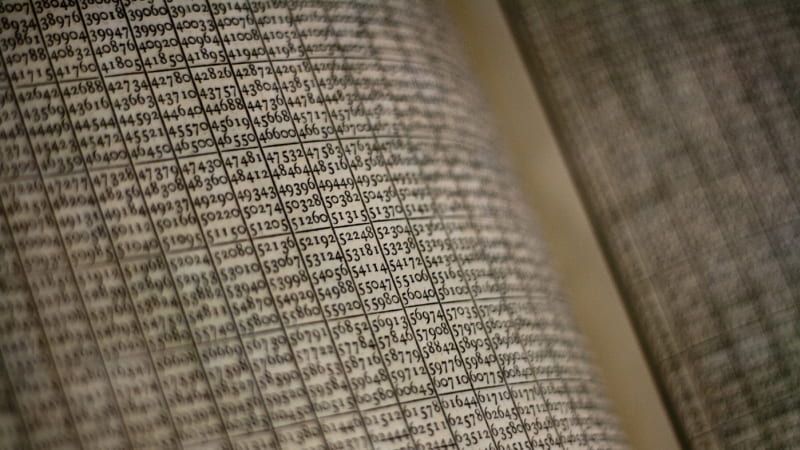BEYOND INFINITY: CANTOR’S INCREDIBLE PROOF
By: Claire Loe

Photo credit: Patrick Gage Kelley/FLICKR
If you were one of the millions of people to go see last summer’s blockbuster film “The Fault in Our Stars,” based off the novel of the same name by John Green, you might have been struck by a piece of mathematical wisdom uttered near the end of the movie: “Some infinities are bigger than other infinities.”
At first glance, this probably seems as somewhat of an odd sentiment. After all, how could one never-ending set of numbers be bigger than another never-ending set of numbers? As hard as it is to conceptualize the sheer vastness of infinity, it goes against all intuition to imagine that one limitless quantity could be bigger than another. But this just so happens to be true, and the proof for it is rather eloquent in its simplicity.
But first, some definitions. There are two types of infinities that I will be talking about: listable and unlistable. These are sometimes called countable and uncountable, but I prefer to use the former nomenclature because, technically, no infinity is countable in the way that we normally think of counting – with regards to a finite amount of items.
Listable infinities are smaller types of infinities and the easiest to conceptualize. Included in this kind of infinity are sets such as integers, even numbers, and rational numbers.
The simplest of these are the natural numbers, which start with one and increase by one: 1, 2, 3, 4, and so on forever. If you had a never-ending supply of time, paper, and ink in the world, you could write down every number in this set, which is why they are called “listable infinities.”
The same holds true for even numbers. Simply take the set of natural numbers, and multiply each entry by two: 2, 4, 6, 8, and continuing forever. This new set of even numbers has exactly one element for every element in the first set, and thus the two are equivalent in size. In fact, you can multiply or divide that first set by any integer to obtain a new listable infinity. Similarly, and with a little ingenuity, you can map the set of all fractions onto that of the natural numbers, proving that although they are both infinitely long, they are of the same size.
Now that we have shown that you can list the contents of some infinities, it is time to prove the opposite. In doing so we will see that this type of infinity, unlistable, is actually larger than the other.
Picture this: you have a number line before you and a highlighter in your hand. By highlighting any segment of that number line, you have just sectioned off a piece of infinity that is in fact larger than those mentioned in the previous paragraph–that is, an unlistable infinity. Even a small section of this number line contains an endlessly large quantity of numbers.
Consider the space between 0 and 1. No matter how cleverly you try to list all of the numbers between the two and map them to the set of the natural numbers, it cannot be done. To demonstrate this, we’re going to do a little experiment discovered by German mathematician Georg Cantor. Grab a pen and make a list of numbers less than 1 and greater than 0, such that there are at least 5 or so decimal places written out. It should look something like this:
0.1234567234…
0.3141592653…
0.0000060000…
0.2347872364…
0.1111888388…
⁞
Now, starting with the first number you listed, circle the digit in the first decimal place. Then circle the digit in the second decimal place of the next number, and so on. You should have a diagonal of circled numbers.
0.1234567234…
0.3141592653…
0.0000060000…
0.2347872364…
0.1111888388…
⁞
Create a new number out of the ones you circled. For example, mine would be 0.11078, and would continue endlessly if I kept on adding numbers to my list.
To prove that this list would indeed be unending, and that I could never write them in such a way that I would include every number between 0 and 1, I’m going to take the new number I created from my list and make some changes according to the following rule: each time there is a 0 in my list, I will make it a 1, and all other numbers will become 0. My new number 0.00100 is now different from every other one on that list . Because of the rules we instilled, we know that this is true.
We can keep on creating new numbers from our infinite list, but by construction the new one will always have a different order of numbers than any of the previous. Similarly, instead of just changing numbers to 0 and 1, we could add 1 to each entry (or subtract 3, or create any arbitrary set of similar rules that changes the nth digit of the nth number on your list) and get even more numbers not previously on our list. Therefore, any attempt to create a comprehensive list of an unlistable infinity will fail miserably. No matter how this list is constructed, will we be missing an infinite amount of numbers.
With Cantor’s proof, we can see that some infinities really are bigger than other infinities, although maybe not in the way that you originally thought. So next time you see The Fault in Our Stars or watch Toy Story and hear Buzz Lightyear shout his famous catchphrase, you can pride yourself in knowing what exactly is beyond infinity.
P.S. Even though we have discussed the mathematics of it, the ideas behind one infinity being bigger than another are still very difficult to internalize. If you didn’t have a pen and paper on hand while reading and would like a better visualization of the math involved, I suggest you check out this helpful video:
